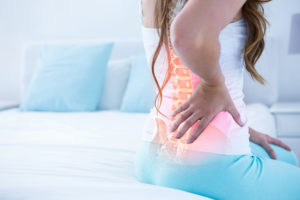
Becky Yoza, DNP
FAMILY MEDICINE
Becky has 14 years combined experience in medical/surgical and emergency nursing. She also teaches undergraduate and graduate nursing at Hawaii Pacific University. Originally a sociologist, Becky trained as a nurse to gain knowledge for her research, but she ended up loving nursing so much she never went back! Born and raised in Michigan, Becky has lived in Hawaii since 2010 and never wants to leave.
Prolapsed Disc (Slipped Disc)
While the terminology is misleading, a disc does not actually slip. In reality, a part of the inner gel-like part of the disc between two vertebrae begins to bulge outwards through a weak spot in the outer part of the disc.

The prolapsed part of the disc can potentially put pressure on a nerve nearby and, as a result, one of the disc prolapse symptoms is a sudden onset of acute lower back pain.
A prolapsed disc is sometimes also referred to as a herniated disc. The bulging disc may occasionally put pressure on other nerves or nearby structures. Some inflammation is also likely to develop around the prolapsed portion of the disc. In addition, inflammation may lead to irritated nerves and also bring about some swelling, which may, as a result, put pressure on a nerve.
Most often, a slipped disc condition happens in the lower lumbar spine. The pain may extend down a leg. The size and severity of the prolapse could vary from person to person. As a general rule, the larger the prolapse, the more severe the symptoms are likely to be.
Who can get a slipped disc?
Most cases of prolapsed discs occur in people between 30 and 50 years of age. Statistically, two times as many men are affected by this condition as women. This condition is rare in anyone below 20 years of age. Less than 1 among 20 cases of sudden and acute back pain are due to a prolapsed disc.
Causes
It is speculated that some people may have a weakness in the outer part of the affected disc making them more prone to this condition. Different factors may trigger the inner softer gel-like part of the disc to squeeze out through the weakened outer harder component of the disc:
- Sneezing
- Awkward bending
- Heavy lifting in an awkward position, may cause extra pressure on the gel-like portion to push itself outwardly
- A job that involves a lot of lifting
- A job that involves lots of driving or sitting upright
- Sports like weightlifting, etc
- Smoking
- Obesity
- Old age
Disc Prolapse Symptoms
Back pain
One of the disc prolapse symptoms is back pain. The pain is often acute and usually comes on suddenly and progresses quickly. The pain is worse if you move your back too much, sneeze or cough.
Nerve root pain (usually sciatica)
When a nerve coming out from the spinal cord – or the root of the nerve – is irritated, inflamed or pressed upon you may experience nerve root pain or sciatica. Sometimes it is also called a trapped nerve and occurs in less than 1 out of every 20 people who complain of acute low back pain.
- There is pain along the length of the nerve.
- Typically pain extends down a leg, sometimes as far as the calf or the foot.
- Pain in the lower back is often not as bad as the pain down the leg or foot.
- You may experience pins and needles, weakness or numbness in part of a buttock, leg or foot.
- Depending on which nerve is affected, weakness could appear in different parts of the body
Cauda equina syndrome – rare, but an emergency
Cauda equina syndrome is a very rare disorder where the nerves at the very bottom of the spinal cord are pressed upon. This disorder can cause:
- Lower back pain
- Problems relating to bowel
- Problems relating to bladder function (usually being unable to urinate),
- Numbness in the saddle area (the groin, buttocks, and upper thighs) around the anus
- Weakness in either or both legs
This syndrome must be treated as an emergency and requires urgent medical treatment so that the bladder and bowel do not become permanently damaged.
Therefore, it is important to note that some people do not have disc prolapse symptoms as prolapsed discs can sometimes be dormant and asymptomatic. This condition does not require medical intervention as long as the prolapse does not put pressure on any nerve. Some prolapses may be small, cause minor insignificant or no symptoms or occur away from the nerves.
How does a slipped disc progress?
- In many cases, the symptoms tend to reduce over a few weeks.
- Studies of repeated MRI scans have revealed that the bulging prolapsed portion of the disc tends to shrink or regress as time progresses.
- In many cases, the symptoms may go away completely.
- About 50 out of every 100 people improve within 10 days of the onset of pain, and almost 75 out of 100 people report marked improvement after four weeks.
- Only a very small number of people, about 2 out of every 100 people with a ‘slipped’ disc are still in severe pain even after 12 weeks may need surgery.
Do I need any tests?
Tests such as X-rays or scans may be necessary if symptoms seem to continue over a long period of time. More specifically, an MRI scan can reveal the precise site and size of a prolapsed disc. If considering surgery as treatment, this information is crucial.
Your doctor should be able to diagnose a ‘slipped’ disc from any disc prolapse symptoms you may present upon physical examination. It is the most common cause of sudden back pain with nerve root pain symptoms
Treatment
Staying active
- Try to continue with normal activities as far as possible. This may not be possible in the beginning if the pain is very bad.
- Move around within the home at least, as soon as you are able to.
- Don’t do anything that causes or increases existing pain.
Sleep
- Remember to sleep in the most comfortable position on whatever surface is the most comfortable, it does not matter if it is hard or soft.
- Some people reported that a small firm pillow tucked between the knees when sleeping on the side helps relieve pain.
Exercise
- Some exercises designed by physiotherapists to work on at home may aid a speedy recovery.
- They may help strengthen lower back muscles in the long run and reduce the chances of recurrence or severity of the pain when it does come again.
- Taking complete bed rest is not the best way to go about managing back pain.
Medication
- Anti-inflammatory painkillers include ibuprofen, diclofenac or naproxen which may require a prescription from a doctor.
- Some people may not be able to take anti-inflammatory drugs. For example, those who suffer from asthma, high blood pressure, kidney failure, or heart failure.
- If anti-inflammatories do not work well, codeine could be considered as an option. This may be consumed as co-codamol, which is codeine with paracetamol and acts as a stronger pain killer. Constipation is a common side-effect of codeine. Therefore this may aggravate back pain if you need to strain to go to the toilet. To circumvent this problem, be sure to have lots of fluids and drink water and eat foods that are rich in fiber.
- Prescription of a muscle relaxer such as diazepam is rare and usually only for a few days if the back muscles become very tense making the pain unbearable. Diazepam can be habit-forming as it provides quick and significant relief from pain and therefore should be taken for a very short period.
- Antidepressants or medicines for neuropathic pain, such as amitriptyline, duloxetine, gabapentin or pregabalin, may rarely be prescribed if the pain has not subsided or reduced for a long period of time.
- If you decide to take painkillers, it is best to take them regularly. This is better than taking them only when the pain is extremely bad. Taking them regularly ensures that the pain is more likely to be relieved for longer periods of time. This allows you to exercise better and keep more active.
Physical treatments
Some people may choose to seek the services of a chiropractor or osteopath for manipulation and/or other physical treatments. While it is still unclear if they provide relief in the long term, they may provide some short-term comfort. It is always recommended that they are accompanied by regular exercise.
Epidural
An epidural is an injection in the back around the area where the sciatic nerve comes out of the spine. Only a specialist can administer an epidural. The injection contains a special combination of local anesthetic and steroids, which is a very strong anti-inflammatory concoction. It is essentially a long-term painkiller that can give you enough pain relief that you can start or continue to exercise and go back to your normal routine activities more quickly.
Surgery
Surgery may be considered an option in some rare cases if the symptoms are very severe and the pain is excruciating, or the symptoms have not reduced even after medical intervention over six weeks or so. The surgery aims to cut out the prolapsed part of the disc and release the pressure on the nerves. This often reduces symptoms. Recent studies reveal that while surgery may be a better option in the short term, it makes no difference in the long term. The effects of the surgery seem to wear off after the first few months.
Can further incidents be prevented?
Research suggests that the best way to prevent future spells of low back pain is simply to be as active as possible and to exercise regularly.
Meet some of our doctors and experts
Here are some of the conditions we treat:
Questions regarding treatment? Contact us! We're here to help.
ALL MAJOR INSURANCE ACCEPTED
Visit with a board-certified Hawaii doctor online or by phone.

Here’s what people are saying
Kaimani
North Shore, Oahu
![]()
"I thought the whole process was pretty cool. To be able do this all on the phone instead of wasting an hour or two to see my doctor and wait all that time to speak with my doctor for only 5 minutes. The best part was I didn't feel rushed either during the video consult. The doctor really took her time speaking with me and more so than my regular doctor would have the time to do so with me.
Susan
Manoa, Oahu
![]()
This was so convenient for me and my family, especially since we are traveling and this saved me a trip to Urgent Care, who knows how long that could have taken. I appreciate how prompt the doctor and the staff were with contacting me.
Meliana
Lahaina, Maui
![]()
This was so great for my Dad to use as he is visiting from another country and he doesnt have health insurance. For something as simple as an earache, we didn't have to spend so much money on a quick doctor's visit. Plus the doctor was able to help my Dad sooner than our scheduled appointment!
Nalu
Mililani, Oahu
![]()
"Everything was very helpful from the initial call down the getting my prescription. I wish I could take this service back home with me to Canada!"
Allie
Lahaina, Maui
![]()
The whole experience was super fast! That was thee fastest appointment I have ever had, especially for something as simple as a prescription refill. Plus I had to pick my son up for school.
Nicki
Kapolei, Oahu
![]()
The fact that I was able to do all of this without getting out of my bed. From the time I made my appointment to hearing my prescription is ready, its been less than 1 hour.
Kawika
Aiea, Oahu
![]()
Video consult was my favorite part. I've never done a telemedicine visit before and it was cool. I can really see this being great for people with busy schedules, not to mention there is nothing like this in Hawaii yet.
Salesi
Lihue, Kauai
![]()
"Convenience from the comfort of your own home. Some times it can be a hassle getting out of house when you're already not feeling well to see your doctor, or even just to get a refill. But this is a very convenient service."
Andrea
Kailua, Oahu
![]()
"Just being able to do it at home and ON TIME was great, because I didn't have to spend the time to commute and spend time in the waiting room to MAYBE see my doctor at my scheduled appointment time. The doctor called me as soon on the dot of my appointment time."
Puka
Waimea, Big Island
![]()
The best part was definitely seeing the doctor on the video call. It is comforting as a patient that there is a real doctor on the other end laying eyes on me and the symptoms I could be having.
Chris
Kona, Big Island
![]()
"The doctor was great and took his time explaining my symptoms and treatment! Actually the whole experience was fantastic! I can't believe how efficient you guys are. It hasn't even been 30 minutes and I've already been contacted by pharmacy that my prescription is ready. This was great. I would definitely use this service again and highly recommend to others!"
We're trusted by local individuals and organizations.









